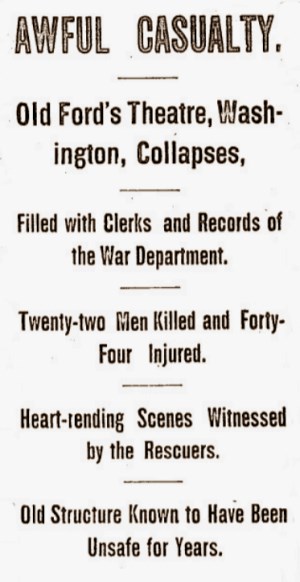
After the assassination of Abraham Lincoln, the United States government seized the Ford's Theatre building. As the scene of the great crime, the theatre remained closed during the government's investigation of the events there. Access to the building was heavily restricted, and military guards stood outside. After the trial and execution of the Booth conspirators in July 1865, the government returned the theatre to owner John T. Ford. Ford immediately announced that the theatre would reopen with the play The Octoroon on July 10. He sold over 200 tickets to this play. However, Ford also received many letters warning him not to reopen the theatre. At least one of these documents contained a threat to burn the building down if it reopened. In response to the perceived threat, Secretary of War Edwin Stanton sent a detachment of soldiers to seize the theatre and turn away ticketholders. Several hundred patrons came out for the reopening. After milling about Tenth Street for several hours, the crowd departed without incident. The following day, Stanton informed John T. Ford that the federal government had confiscated the theatre. Arrangements were later made to compensate Ford for the loss of the property. The government decided to turn the theatre into an office building. Contractors gutted the inside of the theatre to prepare for this transformation. John T. Ford took some of the ornate fixtures for his Holliday Street Theatre in Baltimore, Maryland. These features included the steel columns that supported the Dress Circle (second floor) and Family Circle (third floor). The box occupied by Lincoln was dismantled and placed “under lock and key,” likely at one of Ford’s theatres in Baltimore. 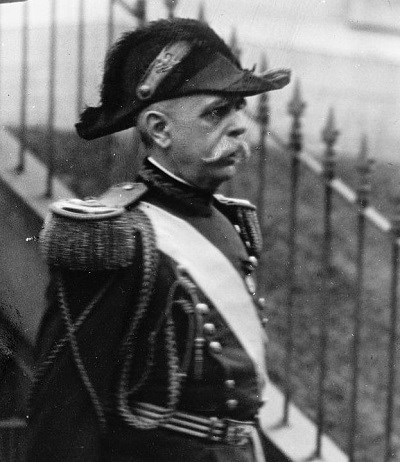
Library of Congress By November 27, 1865, the renovations were complete. The War Department's Record and Pension Bureau moved into the first two floors. The second floor also housed the Library of the Surgeon General’s Office, containing several thousand volumes of medical reference books. The Army Medical Museum moved into the third-floor space in 1867. That museum relocated to a new building on the National Mall twenty years later. At that time, the Record and Pension Bureau took over that space as well. Over the years, many pension clerks complained about the poor and unsafe conditions of the building. In 1886, the War Department hired a new bureau chief, Colonel Fred C. Ainsworth, and authorized interior improvements. Ainsworth made several updates to the building systems. He also implemented heavier workloads and longer hours for the military clerks. This made him an unpopular figure among the staff. 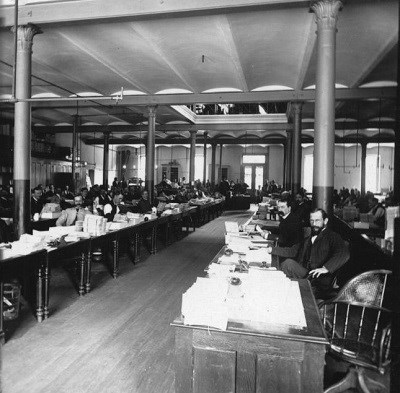
Keystone/Mast Collection, UC Riverside There were over 500 government clerks working in the building by 1893. Several workers expressed concerns about the safety of the building. Ropes cordoned off parts of the building due to concerns with the structure. At the end of the workday, the supervisors released the workers floor-by-floor, so as not to put too much weight on the main staircase. Many of the clerks worried about a noticeable bulge in the east wall. Some also observed pieces of plaster falling from the walls and ceiling. Ainsworth's superiors told him that the wall was secure and that the whole building was safe. In 1893, Ainsworth received permission to install an electric light plant for the building as part of the modernization efforts. To install the light plant and provide ventilation for the area, workers had to excavate 12 feet between two partition walls in the basement. This work took place near the brick piers that held up the posts and beams throughout the building. 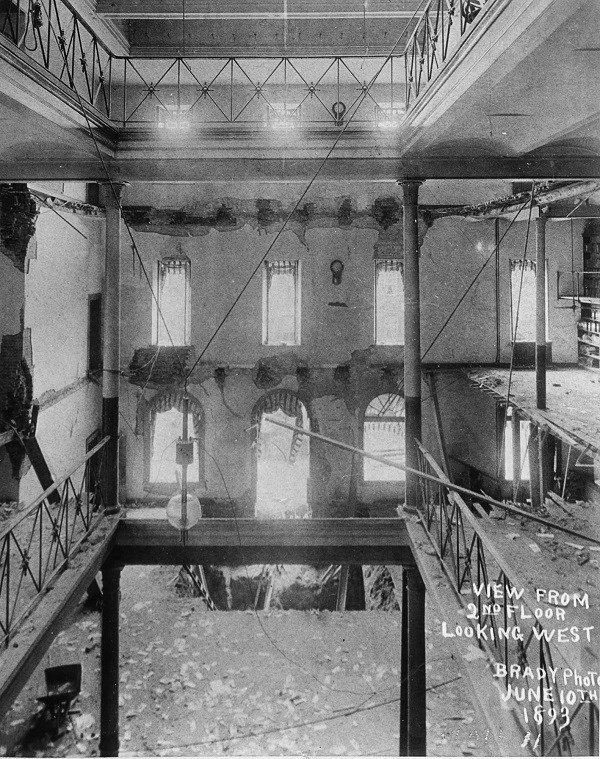
Library of Congress On Friday, June 9, 1893, at 9:30 am one of the brick support piers in the basement collapsed. One clerk reported a “rumble like an earthquake” followed by a “great roar” and a crash “like the end of the world.” Floor by floor, in a domino effect working upwards, the columns collapsed. As they fell, they released the beams and floors they supported, which in turn dropped the higher columns, beams, and floors. The collapse left a 40-foot hole through all three stories of the building. Desks, chairs, tables, pension files, floorboards, and the dead and dying lay in a chaotic and dusty heap on the lowest level of the building. 22 workers died, and at least 68 more were injured. During this tragedy, there was a great moment of heroism. Basil Lockwood, a young African American man, rushed to a back window to help. He climbed a telegraph pole and held a ladder to one of the third-floor windows, helping survivors to escape. His efforts saved around twenty clerks. For his heroics, the War Department clerks gave him an inscribed gold watch. They also petitioned Secretary of War Daniel Lamont to give Lockwood a job. Three months later, the War Department rewarded Lockwood with a job as a messenger that paid $55 a month. Sadly, he lost this job seven months later due to budget cuts. 
Library of Congress 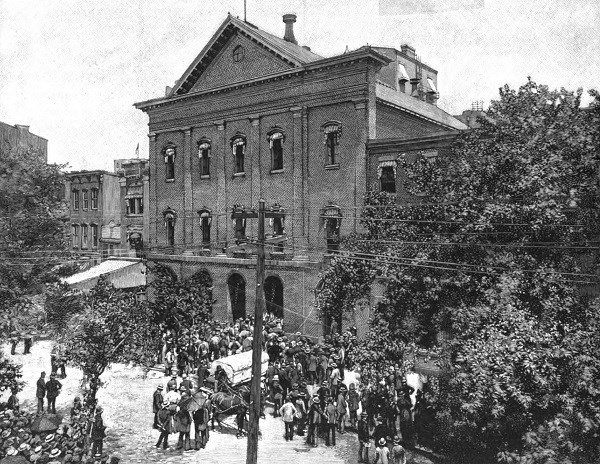
It took days to remove the bodies and the rubble. Even before the work was completed, the surviving clerks and the public wanted to know who was responsible for the collapse. Many blamed Colonel Ainsworth. Others accused the contractor, George Dant, who had been hired for the work. A coroner’s inquest took place to rule on any criminal responsibility. After deliberations, the jurors of the inquest found Ainsworth, Dant, the building superintendent, and the engineer guilty of criminal negligence and recommended prosecution. The jury particularly found fault with Dant, who they determined was responsible for not properly shoring up the brick piers before excavation. The findings of the inquest were forwarded to the district attorney. The district attorney determined that the superintendent and engineer were not criminally responsible. Charges against Ainsworth and Dant were eventually dropped as well. The families of the deceased clerks received $5000 from the federal government. Those who were injured received between $50 and $5000. Workers repaired the damaged floors and prepared to repurpose the building again. From 1893 to 1928, the old Ford's Theatre became an office and storage facility for the War Department. On July 1, 1928, the War Department transferred the building to the Office of Public Buildings and Public Parks of the National Capital. In 1933 the National Park Service took control of the theatre and the Petersen House. The NPS first transformed the theatre into the Lincoln Museum, with exhibits and artifacts on the president's life. In the 1960s, a campaign began to restore Ford's Theatre to its wartime appearance. The renovation work was completed in 1968, and Ford's Theatre reopened as a live theatre and historic site. Today, you can come visit this famous site in American history. Want to Learn More?
|
Last updated: December 1, 2024



